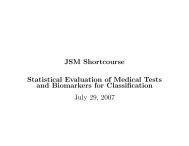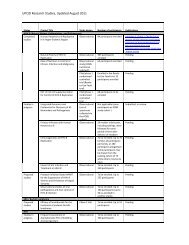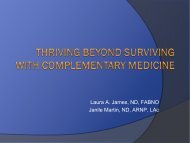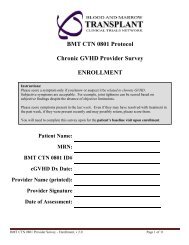Summer Undergraduate Research Program - Fred Hutchinson ...
Summer Undergraduate Research Program - Fred Hutchinson ...
Summer Undergraduate Research Program - Fred Hutchinson ...
You also want an ePaper? Increase the reach of your titles
YUMPU automatically turns print PDFs into web optimized ePapers that Google loves.
Identification of Candidate Minor Histocompatibility (H) Antigens for the Development<br />
of T Cell Immunotherapy to Enhance the Graft Versus Leukemia (GVL) Effect<br />
Amber Ortiz 1 , Julia Richardt, PhD 2 , Stanley Riddell, MD 2 and Marie Bleakley, MD/PhD 2<br />
1 FHCRC – SURP, 2 <strong>Program</strong> in Immunology, Clinical <strong>Research</strong> Division, FHCRC, Seattle, WA<br />
INTRODUCTION METHODS/RESULTS<br />
METHODS/RESULTS CONTINUED<br />
ATP8B4<br />
A. Healthy<br />
Cancer<br />
Other Diseases B.<br />
2. PCR Sequencing The reported population distribution of the allelic variants of SNPs is not always<br />
accurate in the entrez SNP database. PCR sequencing was performed to confirm the population<br />
ALL Prostate<br />
Hematopoietic<br />
distribution of the SNPS in order to validate the candidate minor H antigens and prioritize them for<br />
AML<br />
subsequent studies.<br />
2011 Best Poster Presentation Award<br />
Non-hematopoietic<br />
Figure 5A. PCR Gel Primers were designed for each of the eight SNPs and PCR was conducted. The<br />
above gel was run to show PCR products were formed in the reaction prior to sequencing.<br />
7_ RS12601317_1F2R_2_2F<br />
A/G<br />
C.<br />
AML<br />
8_ RS12601317_1F2R_2_2F<br />
G<br />
9_ RS12601317_1F2R_2_2F<br />
A<br />
Acute Myeloid Leukemia (AML) is a life-threatening hematological cancer in<br />
which the bone marrow makes an abundance of abnormal blasts or immature<br />
blood cells. These malignant blasts divide rapidly and are unable to mature<br />
preventing normal cells from being made and maturing into platelets, white,<br />
or red blood cells. AML can often be cured by allogeneic stem cell<br />
transplantation (SCT). The efficacy of SCT, where donor hematopoietic cells<br />
including stem cells and lymphocytes are infused into the patient following<br />
myeloablative chemotherapy and radiotherapy, is due in part to an immune<br />
response, the GVL effect, where the donors T cells eliminate leukemia.<br />
Unfortunately, AML relapse sometimes occurs after SCT and is generally<br />
fatal. Another immune response that may occur is Graft versus Host Disease<br />
(GVHD). GVHD occurs when transplanted T cells attack the recipient’s<br />
normal organs like skin, gut, liver, and lungs. The major molecular targets of<br />
GVL and GVHD are minor H antigens; polymorphic peptides that are<br />
presented on the cell surface with MHC molecules and are derived from selfproteins<br />
differing in sequence between donors and recipients due to genetic<br />
polymorphisms, most commonly single nucleotide polymorphisms (SNPs). T<br />
cells specific for minor H antigens predominantly expressed on<br />
hematopoietic cells including leukemia can induce a selective GVL effect<br />
without GVHD. Other T cells can recognize minor H antigens that are<br />
expressed ubiquitously including epithelial tissues causing GVHD. T cell<br />
therapy targeting hematopoietic-specific minor H antigens may prevent<br />
relapse of AML following SCT.<br />
Figure 5B. Sample Population Data This is an example of primer 1260 on three of our samples<br />
showing a heterozygote (A/G), homozygote (G/G) and homozygote (A/A) in the SNP sequence. The<br />
sequence data was used to obtain sample population information on the SNPs.<br />
Figure 1. GeneSapiens Database This figure shows the expression pattern of the gene ATP8B4 in nonhematopoietic<br />
tissue and AML. Figure A shows the overall expression of the gene in healthy tissue (left) and that<br />
of certain cancers and other diseases (right). Figure B shows gene expression in normal tissue (nonhematopoietic<br />
in red) Figure C shows gene expression in cancers and other diseases. (AML surrounded in red)<br />
Previous minor H antigen discovery strategies have not been adequately<br />
focused on identifying minor H antigens which are exclusively expressed on<br />
hematopoietic cells. Our goal is to locate minor H antigens that can be used<br />
to develop an immunotherapy to enhance the GVL effect after allogeneic<br />
SCT and which will not induce GVHD. Specifically, we aim to identify minor H<br />
antigens presented by HLA-A*0201, the most common Caucasian HLA<br />
restricting allele in order to target a large population of AML donor/patient<br />
pairs. We are evaluating a reverse immunology approach to the discovery of<br />
hematopoietic-restricted minor H antigens for the development of<br />
immunotherapy, first using bioinformatics to identify candidate minor H<br />
antigens associated with genes expressed exclusively in hematopoietic tissue.<br />
Why are Minor H Antigens Important?<br />
oThey are molecular targets for GVL and GVHD<br />
oThey can be used as targets for T cell immunotherapy to induce an antileukemic<br />
effect<br />
151<br />
(GVL:<br />
anti-leukemic anti leukemic effect)<br />
Figure 5C. Sample Population Data Using PCR and Sequencing we have obtained the above population<br />
data for phenotype distribution confirmation for the 30 samples on eight SNPs. We observed that<br />
seven SNPs are adequately polymorphic to proceed for subsequent studies.<br />
DISCUSSION<br />
Figure 2. Entrez SNP/Gene Database. SNP data was obtained on 34 genes with expression restricted to<br />
hematopoietic tissue. We aimed to identify non-synonymous SNPs with a heterozygosity of >.1 suggesting a<br />
balanced population distribution. 26 SNPs with these characteristics were found within 15 of the 34 genes.<br />
The Genesapiens database was used to identify 34 genes that are highly expressed in AML but not in<br />
non-hematopoietic tissues. Using Entrez SNP we identified, in these genes, 26 non-synonymous SNPS<br />
with a balanced population distribution which could be applicable to many patient/donor pairs. We<br />
verified the population distribution using PCR-sequencing. Epitope prediction algorithms (IEDB) were<br />
applied to amino acid sequences encompassing selected SNPs. IEDB identified 26 peptides predicted<br />
to bind to HLA-A*0201 for eight genes. Using PCR sequencing we narrowed the list to seven peptides<br />
for which there will be donor/patient pairs with the relevant directional disparity.<br />
Peptide Data<br />
Gene<br />
AIMS<br />
Peptide Data<br />
Gene<br />
1. To use a bioinformatic approach to identify candidate minor H antigens<br />
that are A) encoded by hematopoietic restricted genes B) associated<br />
with SNPs having a balanced population distribution C) predicted to bind<br />
to HLA-A*0201.<br />
2. To use PCR sequencing to verify the SNP population distribution in order<br />
to prioritize candidate minor H antigens for further studies.<br />
CONCLUSIONS and FUTURE DIRECTIONS<br />
Figure 3. Entrez SNP Database This figure shows examples of SNP data available in the Entrez SNP database<br />
for two candidate minor H antigens.<br />
We identified seven candidate minor H antigens representing polymorphic peptide sequence<br />
predicted to bind to HLA-A*0201 associated with SNPs confirmed (figure 4) to have a balanced<br />
population distribution (figure 5c). Each candidate minor H antigen is encoded by a gene which is<br />
highly expressed in AML and not hematopoietic tissue (figure 1).<br />
METHODS/RESULTS<br />
Future studies in the Riddell lab will be performed to demonstrate binding of the candidate minor H<br />
antigens to HLA-A*201 in vitro. Studies will also be conducted to evaluate the immunogenic and<br />
endogenous processing/presentation of the minor H antigens.<br />
Ultimately, the candidate minor H antigens may be used as targets for immunogenicity to prevent and<br />
treat relapse of AML after allogeneic SCT.<br />
1. Bioinformatics<br />
163 enes<br />
Gene Sapiens Database<br />
http://ist.genesapiens.org<br />
http:// ist.genesapiens.org//<br />
34 Genes with high expression levels in AML and low expression levels in<br />
non-hematopoietic tissues<br />
Entez Gene/SNP PubMed Database<br />
http://www.ncbi.nlm.nih.gov<br />
http:// www.ncbi.nlm.nih.gov/gene/ /gene/<br />
http://www.ncbi.nlm.nih.gov/snp<br />
http:// www.ncbi.nlm.nih.gov/snp<br />
ACKNOWLEDGEMENTS<br />
The <strong>Summer</strong> <strong>Undergraduate</strong> <strong>Research</strong> <strong>Program</strong> is supported in parts by the Cancer Center<br />
Support Grant (CCSG) CURE Supplement: 5 P30 CA015704-37S1 and FHCRC Administrator<br />
This work has been supported by the Damon Runyon Cancer <strong>Research</strong> Foundation via Dr. Marie<br />
Bleakley’s Clinical Investigator Award<br />
We would like to thank the MARC program supported by Award Number T34GM00851 from the<br />
National Institute of General Medical Sciences<br />
26 Non-synonymous SNPs with balance population distribution (15 Genes)<br />
SYFPEITHI AND IEDB Database<br />
http://www.syfpeithi.de<br />
http:// www.syfpeithi.de/ /<br />
http://www.immuneepitope.org<br />
http:// www.immuneepitope.org//<br />
Figure 4. IEDB Database Using the IEDB database for epitope predictions we identified 26 peptides from eight<br />
SNPs predicted to bind to HLA-A*0201 with a high binding affinity (IC50
















